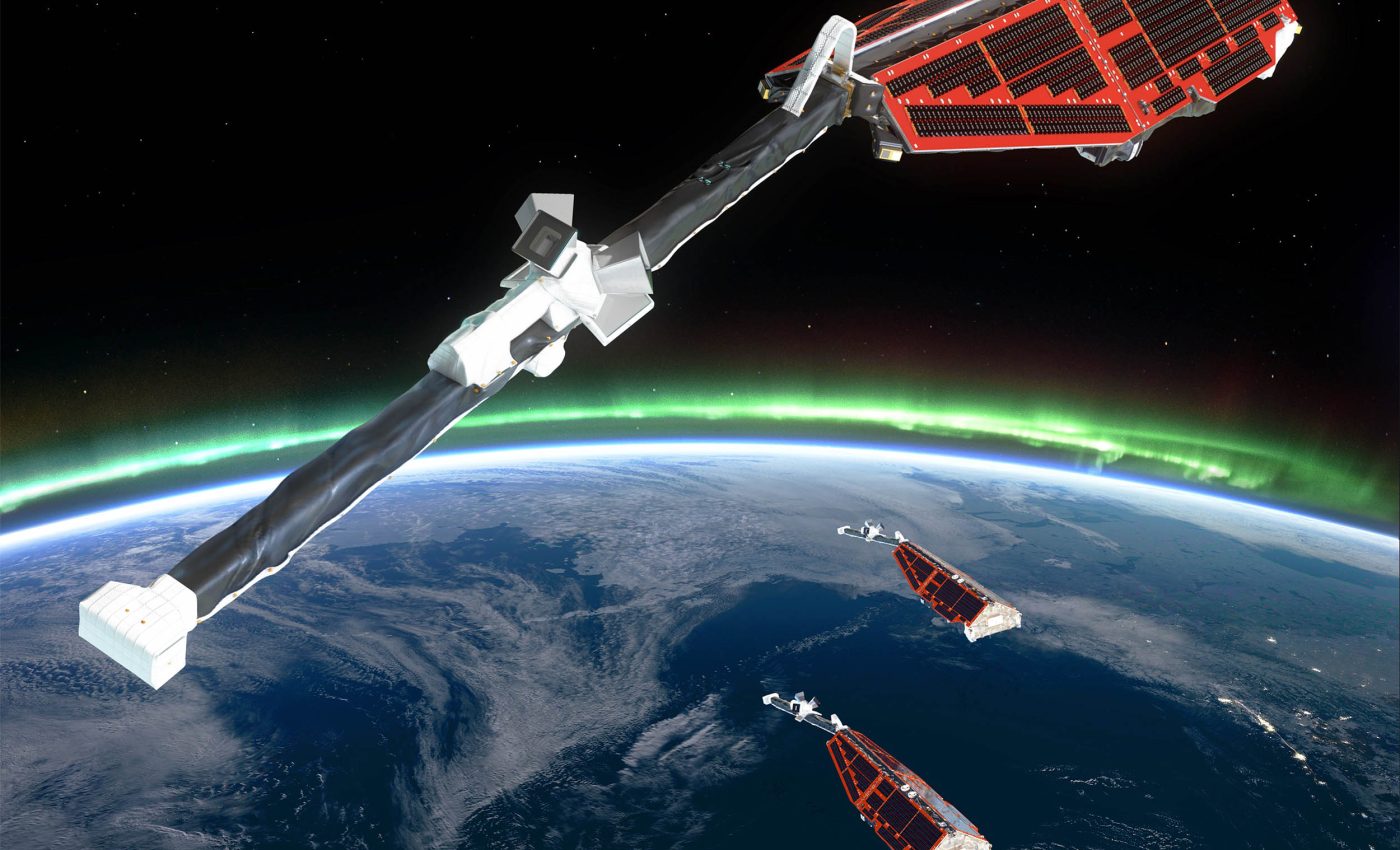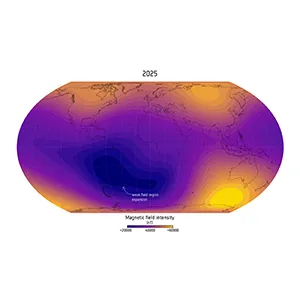
Satellite mission finds a growing weak spot in Earth's magnetic field
The magnetic field that protects our planet is shifting – and one region is fading fast. Over the South Atlantic, a weak spot in Earth’s magnetic shield has grown steadily since 2014. It now stretches across an area nearly half the size of continental Europe.
The finding, drawn from 11 years of measurements by the European Space Agency’s Swarm satellite constellation, sharpens scientists’ picture of a restless magnetic field that strengthens in some regions even as it fades in others.
Earth’s magnetic field in motion
Earth’s magnetic field is our first line of defense against high-energy particles from space.
Generated mostly by a churning ocean of molten iron nearly 1,860 miles (3,000 kilometers) beneath our feet, the field behaves less like a tidy bar magnet and more like a living, shifting force.
Electrical currents in the liquid outer core constantly sculpt and reshape the field. At the same time, additional magnetic signals from the crust, oceans, ionosphere, and magnetosphere add layers of complexity.
Launched in 2013 under ESA’s FutureEO program, the Swarm mission flies three identical satellites in coordinated orbits to disentangle those overlapping sources.
By measuring the field’s strength and direction with exquisite precision, Swarm has built the longest continuous record of Earth’s magnetism.
The satellite has also delivered insights crucial for science, navigation, and space weather forecasting.
South Atlantic Anomaly expands
One feature has commanded special attention: the South Atlantic Anomaly, or SAA. It’s a broad zone where the magnetic field is unusually weak. Scientists first charted it in the 19th century, southeast of South America.
Spacecraft passing through the SAA are exposed to higher doses of radiation, increasing the risk of glitches, instrument degradation, or even temporary blackouts.
Swarm analyses show the SAA has grown steadily from 2014 to 2025. More striking still, its evolution is not uniform.
Study lead author Chris Finlay is a professor of geomagnetism at the Technical University of Denmark.
“The South Atlantic Anomaly is not just a single block,” said Professor Finlay. “It’s changing differently toward Africa than it is near South America. There’s something special happening in this region that is causing the field to weaken in a more intense way.”
Magnetic reversal signals under Africa
Since 2020, a sector of the Atlantic southwest of Africa has seen an even faster decline in field strength than the SAA as a whole.
Swarm’s measurements point to unusual structures at the boundary between the liquid outer core and the solid mantle.
“Normally we’d expect to see magnetic field lines coming out of the core in the Southern Hemisphere,” Finlay explained.
“But beneath the South Atlantic Anomaly we see unexpected areas where the magnetic field, instead of coming out of the core, goes back into the core.
“Thanks to the Swarm data, we can see one of these areas moving westward over Africa, which contributes to the weakening of the South Atlantic Anomaly in this region.”
Mapping Earth’s magnetic field
Swarm’s long, stable time series is what makes these subtleties visible. This mission has far outlived its original design.
The data now underpin global magnetic models used in navigation systems, support operational space weather services, and help scientists probe processes from Earth’s core to the edge of space.
“It’s really wonderful to see the big picture of our dynamic Earth thanks to Swarm’s extended time series,” said Anja Strømme, ESA’s Swarm mission manager.
“The satellites are all healthy and providing excellent data, so we can hopefully extend that record beyond 2030, when the solar minimum will allow more unprecedented insights into our planet.”

Strongest magnetic “hubs”
The latest results also highlight dramatic rebalancing in the northern hemisphere’s two strongest magnetic “hubs.”
Over Siberia, the field has strengthened during Swarm’s watch, while over Canada it has weakened.
The Canadian strong-field region has shrunk by about 0.65 percent of Earth’s surface area. In contrast, the Siberian part has grown by 0.42 percent.
These shifts align with the observed drift of the north magnetic pole toward Siberia. That migration affects compass-based navigation and the magnetic models used in everything from smartphones to ships.
In the southern hemisphere, a single dominant strong field point provides a counterweight to the SAA’s weakness, underscoring the field’s asymmetry.
“When you’re trying to understand Earth’s magnetic field, it’s important to remember that it’s not just a simple dipole, like a bar magnet,” Finlay continued.
“It’s only by having satellites like Swarm that we can fully map this structure and see it changing.”
Deeper story of the magnetic shield
For spacecraft operators, the SAA’s steady spread and evolving intensity are more than academic curiosities.
Satellites lingering in the region face a higher flux of energetic particles, which can flip bits in onboard computers, scar detectors, or degrade solar panels.
Understanding the SAA’s contours and its year-to-year variability helps mission teams plan orbits, harden systems, and schedule sensitive operations outside the riskiest zones.
For geophysicists, the SAA is also a window into the deep Earth processes that sculpt the magnetic field.
Reverse flux patches and drifting core features shape geodynamo models that explain how Earth generates its magnetic field. This is the engine that converts the core’s heat and motion into magnetism.
Those models, in turn, help assess long-term trends in field strength, the likelihood of future weakening in critical regions, and the broader implications for Earth’s radiation environment.
As Swarm continues to fly, its three sentinels will keep tracing those magnetic fingerprints across the globe.
Together, they reveal a shield in flux – weakening above parts of the South Atlantic, strengthening over Siberia, and never standing still.
The study is published in the journal Physics of the Earth and Planetary Interiors.
—–
Like what you read? Subscribe to our newsletter for engaging articles, exclusive content, and the latest updates.
Check us out on EarthSnap, a free app brought to you by Eric Ralls and Earth.com.
—–













